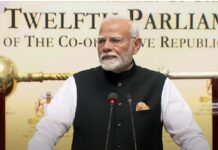International NASH Day – 8th June, 2023
Non-alcoholic fatty liver disease: an ominous public health problem
Non-alcoholic fatty liver disease (NAFLD) is a major cause of chronic liver disease both worldwide and in India. Globally around 25-30% of all individuals have underlying NAFLD. In India, the burden is even more alarming and in Chandigarh it is estimated that almost 1 in 2 persons might be having underlying NAFLD said Dr Arka De, Assistant Professor, Department of Hepatology, PGIMER, Chandigarh. NAFLD refers to the excessive accumulation of fat in the liver in the absence of other causes of liver diseases including significant alcohol intake. In a quarter of patients, this fat in the liver can causeinflammation (swelling) and scarring (fibrosis)of the liver and the severe form of fatty liver called nonalcoholic steatohepatitis (NASH), which may progress to cirrhosis and livercancer in the long run. It extremely important to create awareness of NAFLD which may be considered to be a “silent killer” as it often remains asymptomatic in the early stages.
NAFLD is primarily a lifestyle disease with insulin resistance being a central driver. At the most basic level NAFLD may be considered a state of energy excess where the dietary calorie intake exceeds the calories that are burnt out during physical exertion resulting in fat accumulation in the liver. Given the central role of insulin resistance, it is not surprising that NAFLD is closely associated with other chronic metabolic diseases like obesity, type 2 diabetes mellitus and hypertension. On the one hand, patients with obesity and diabetes are more likely to have NAFLD, while on the other hand patients with NAFLD are more likely to be diabetic or obese. More importantly, NAFLD in patients with metabolic co-morbidities like obesity, type 2 diabetes mellitus or hypertension have a higher risk of developing severe liver disease, said Dr De.
Given the fact that NAFLD is primarily a lifestyle disease, lifestyle interventions are the mainstay for both the prevention and management of NAFLD. This entails both dietary calorie restriction and exercise which should go hand in hand. Indeed, pharmacotherapy for NAFLD has a limited role in only a selected group of patients. It is also important to emphasize that the management of NAFLD should be holistic and other metabolic disorders including diabetes, hypertension and dyslipidemia should be adequately controlled. Indeed, a healthy lifestyle will help prevent and manage not just NAFLD but also these chronic disorders thereby targeting “multiple birds with a single stone”said Dr De.
It is clear that creating awareness among the general public about NAFLD, its risk factors and the importance of lifestyle management is crucial to tackle this emerging pandemic. International NASH day was initiated in 2018 by Global Liver Institute (GLI), USA to create awareness about this emerging disease entity. This year it will be observed on8th June 2023 (Thursday) and various education programs will be conducted by the Dept of Hepatology, PGIMER, Chandigarh stretching through the whole month in order to make people aware about this potentially preventable and reversible disease, said Dr Ajay Duseja, Professor and Head, Department of Hepatology, PGIMER, Chandigarh.
Dr Duseja who is also the Secretary-General of Indian National Association for Study of the Liver (INASL) informed that INASL has initiated two important programs for the prevention and control of NAFLD in India.
A recent meta-analysis from India has shown the prevalence of NAFLD to be 38.6% in adults and 35% in children. Since the reason for high prevalence of fatty liver in children is related to childhood obesity, INASL has tied up with the Rotary International to launch the ‘Fatty Liver ROCCO Campaign by INASL’ [INASL and Rotary Combating Childhood Obesity (ROCCO) and Fatty Liver Campaign].
The campaign will be announced on 8th June, 2023 (International Day- 2023) and enrolment in the program will start by next month. The aim of the program is to stop obesity and fatty liver in children (ROCCO) by sensitizing the parents and children about obesity and fatty liver through their schools and teachers. A website for the program has been designed and will be initially opened to 2-3 states of the country as a pilot project. If successful, it will then be applied all over the country, said Dr Duseja.
NAFLD is a non-communicable disease (NCD) which occurs due to metabolic abnormalities like diabetes mellitus, obesity, hypertension and dyslipidemia. However, NAFLD is not getting the required attention as is given to other NCDs. INASL is also collaborating with European Association for the Study of the Liver (EASL) and in a recently held meeting in Geneva on the sidelines of World Health Assembly 76, EASL in association with INASL and various other organizations held a meeting on ‘Together for Better Liver Health’ and decided to call for a ‘Global Action for a Global Problem’ and an urgent call to action at WHO by including NAFLD into various other non-communicable diseases, said Dr Duseja.
Risk factors for NAFLD:-
1. Increased intake of calories in diet.
2. Sedentary lifestyle.
3. Urbanisation.
4. Overweight and obesity.
5. Type 2 diabetes mellitus.
6. Hypertension.
7. Altered lipid profile with high levels of triglycerides and low HDL (good cholesterol).
Practical tips on lifestyle interventions for NAFLD
1. Weight loss-Target weight loss of 7-10% in overweight or obese patients with NAFLD
2. Diet
Daily calorie intake should be decreased by 500-1000 kcal or approximately 1/3rdby cutting down on carbohydrates and fats in the staple diet.
Total fat should not exceed 30% of total energy intake. Intake of saturated fats should be <10% of total energy intake.
Avoid trans-fats (fried or battered food, junk-food, margarine etc) of total energy intake
Carbohydrates should be restricted to <50% of total energy intake.
Limit intake of free sugars Fructose and sweetened beverages should be curtailed.
Some evidence of the benefit of >2 cups of caffeinated coffee per day.
Various popular diets are now in vogue.
Mediterranean diet may have some benefit but is difficult to implement in Indian settings.
Calorie restriction appears is more important than the specific type of diet per se.
Diet sourced from locally available materials and consistent with the traditional cuisine is more likely to be adhered to it long term.
Abstain from alcohol
3. Excercise
Moderate intensity aerobic or resistance exercises 30-45 minutes/day at least 5 days in a week in all patients irrespective of body weight.
Resistance exercises can supplement aerobic exercises.
This may be particularly useful for patients with who cannot otherwise partake in aerobic exercises like patients with arthritis, morbid obesity, etc.
Yoga may be beneficial as has been shown in diabetes and hypertension.
















